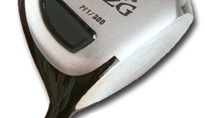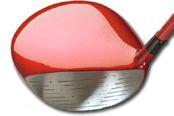GOLF EQUIPMENT
|
|
And what does Baran say about the PFT/300? “It’s a bit of a new angle for them. The Maraging Power appealed to traditionalists, with it’s smaller [230cc] head. But the PFT/300 has a bigger head and this revolutionary new steel. It’s a bit of a bow to the market’s demand for larger clubheads, but it’s definitely KZG good and KZG long. The high-tech crowd loves it” In fact, Baran was probably the first person in Canada to lay hands on the new PFT/300, but he soon lost it. “That club is firmly ensconced in the bag of a good friend of mine. He’ll never give it up.” Personally, I’m one of those traditionalists whose tastes run toward the KZG Maraging Steel, but I must admit that when I received my own PFT/300, it sent a little thrill up my spine. The clubhead comes in your standard midnight black, but it also comes in passionate purple and candy apple red. And when my club arrived, with it’s red clubhead and matching red AJTech 4470 (stiff) shaft, I couldn’t wait to get to the practice tee.
KZG VP Lisa Shinnerer had warned me of one thing, however: “It has, how shall I say this, a very distinct sound when you hit the ball.” I found that Shinnerer wasn’t lying. When the PFT/300 contacts the ball, it sounds as if you’re hitting a railroad spike with a sledgehammer. And people do stare. Even Scot Baran notes that his customers love the club, “If they can get past the noise.” Shinnerer said KZG thought about trying to dampen it, but decided against it – who would want to mess with this sort of distance?
And how does the new driver perform? Well, I’m not sure it beats the Maraging Power, but it is no shorter, either. Being used to smaller driver heads as I am, it took a little while to get used to the very light 300cc clubhead, but when my weight stayed back and my wrists turned over fast enough (and I stopped over-swinging), the PFT/300 simply crushed the ball. The 9-degree model sent the ball out on a rope. And after passing it around to a few other golfers of varying handicaps, most found the same thing: Solid in-air distance and considerable roll.
The only issue is the effect of that ultra-thin face on an off-center hit. With thicker, more uniform clubfaces, missing the sweetspot is less of an issue. However, when a clubface varies in thickness, becoming thinner out toward the periphery of the club, off-center hits seem to me to be penalized more in terms of distance. This is of course a concern with all clubs – from drivers to putters – but it is worth keeping in mind that just because a clubhead is big doesn’t mean you can make sloppy contact and expect optimal results, especially if the part of the clubface that hits the ball is only 1.8mm thick.
 Priced between $350-400 (depending on shaft, etc.), the PFT/300 qualifies as a premium driver. But KZG has grown its following and market share largely underground, and in just a few short years, it’s equipment has fully earned the label of “premium.” And although the sound it makes on contact is, um, “distinctive,” most folks can get used to it. In fact, I developed a great drill to work on my swing tempo: I tee up six balls in a row and start singing “I’ve been working on the railroad all the livelong day….” On every fourth beat, I whack a ball.
Priced between $350-400 (depending on shaft, etc.), the PFT/300 qualifies as a premium driver. But KZG has grown its following and market share largely underground, and in just a few short years, it’s equipment has fully earned the label of “premium.” And although the sound it makes on contact is, um, “distinctive,” most folks can get used to it. In fact, I developed a great drill to work on my swing tempo: I tee up six balls in a row and start singing “I’ve been working on the railroad all the livelong day….” On every fourth beat, I whack a ball.
What other club comes in bright red or purple AND with it’s own sound effects?
Club Specifications
Suggested retail price: $349-399Clubhead: 17/4 stainless steel
Clubface: proprietary steel alloy
Clubhead size: 300cc
Clubhead weight: 198g
Lofts: 7.5, 9, 10.5, 12 degrees (RH); 9 and 10.5 degrees (LH)
Lie: 56-degrees
Face height: 50mm
Length: 45”
Shafts available: AJTech, Grafalloy, UST, Royal Precision, Rifle, True Temper
Colors available: midnight black, passionate purple, candy apple red
Address: 3735 Cahuenga Blvd., West Studio City, CA 91604
Phone: 800-200-8800
E-mail: sales@kzgolf.com
Web: www.kzgolf.com
 KZ Golf's PFT/300 Driver
KZ Golf's PFT/300 Driver